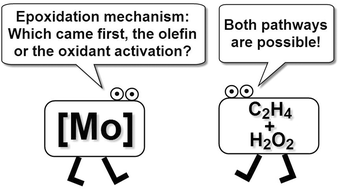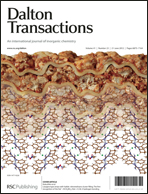[Mo(O)(O2)2(L)2] compounds (L = pz, pyrazole; dmpz, 3,5-dimethylpyrazole) were reacted stoichiometrically, in the absence of an oxidant, with cis-cyclooctene in an ionic liquid medium where selective formation of the corresponding epoxide was observed. However, this oxo-transfer reaction was not observed for some other olefins, suggesting that alternative reaction pathways exist for these epoxidation processes. Subsequently, DFT studies investigating the oxodiperoxomolybdenum catalysed epoxidation model reaction for ethylene with hydrogen peroxide oxidant were performed. The well known Sharpless mechanism was first analysed for the [Mo(O)(O2)2(dmpz)2] model catalyst and a low energy reaction pathway was found, which fits well with the observed experimental results for cis-cyclooctene. The structural parameters of the computed dioxoperoxo intermediate [Mo(O)2(O2)(dmpz)2] in the Sharpless mechanism compare well with those found for the same moiety within the [Mo4O16(dmpz)6] complex, for which the full X-ray report is presented here. A second mechanism for the model epoxidation reaction was theoretically investigated in order to clarify why some olefins, which do not react stoichiometrically in the absence of an oxidant, showed low level conversions in catalytic conditions. A Thiel-type mechanism, in which the oxidant activation occurs prior to the oxo-transfer step, was considered. The olefin attack of the hydroperoxide ligand formed upon activation of hydrogen peroxide with the [Mo(O)(O2)2(dmpz)2] model catalyst was not possible to model. The presence of two dmpz ligands coordinated to the molybdenum centre prevented the olefin attack for steric reasons. However, a low energy reaction pathway was identified for the [Mo(O)(O2)2(dmpz)] catalyst, which can be formed from [Mo(O)2(O2)(dmpz)2] by ligand dissociation. Both mechanisms, Sharpless- and Thiel-type, were found to display comparable energy barriers and both are accessible alternative pathways in the oxodiperoxomolybdenum catalysed olefin epoxidation. Additionally, the molecular structures of [Mo(O)(O2)2(H2O)(pz)] and [Hdmpz]4[Mo8O22(O2)4(dmpz)2]·2H2O and the full X-ray report of [Mo(O)(O2)2(pz)2] are also presented.


 Please wait while we load your content...
Please wait while we load your content...